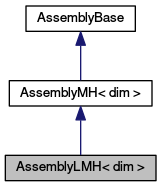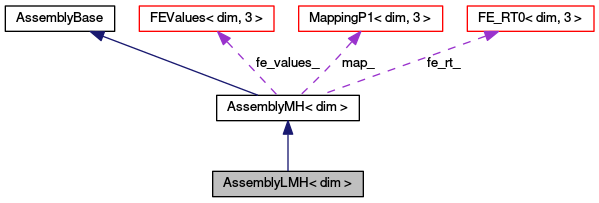#include <assembly_lmh.hh>
Inheritance diagram for AssemblyLMH< dim >:

Collaboration diagram for AssemblyLMH< dim >:

Public Types | |
| typedef std::shared_ptr< RichardsLMH::EqData > | AssemblyDataPtr |
 Public Types inherited from AssemblyBase Public Types inherited from AssemblyBase | |
| typedef std::shared_ptr< DarcyMH::EqData > | AssemblyDataPtr |
| typedef std::vector< std::shared_ptr< AssemblyBase > > | MultidimAssembly |
Public Member Functions | |
| AssemblyLMH (AssemblyDataPtr data) | |
| void | reset_soil_model (LocalElementAccessorBase< 3 > ele) |
| void | update_water_content (LocalElementAccessorBase< 3 > ele) override |
| void | assemble_sides (LocalElementAccessorBase< 3 > ele) override |
| void | assemble_source_term (LocalElementAccessorBase< 3 > ele) override |
 Public Member Functions inherited from AssemblyMH< dim > Public Member Functions inherited from AssemblyMH< dim > | |
| AssemblyMH (AssemblyDataPtr data) | |
| ~AssemblyMH () override | |
| void | fix_velocity (LocalElementAccessorBase< 3 > ele_ac) override |
| void | assemble (LocalElementAccessorBase< 3 > ele_ac) override |
| void | assembly_local_vb (ElementFullIter ele, Neighbour *ngh) override |
| arma::vec3 | make_element_vector (ElementFullIter ele) override |
 Public Member Functions inherited from AssemblyBase Public Member Functions inherited from AssemblyBase | |
| virtual | ~AssemblyBase () |
Public Attributes | |
| AssemblyDataPtr | ad_ |
| bool | genuchten_on |
| double | cross_section |
| std::shared_ptr< SoilModelBase > | soil_model |
Additional Inherited Members | |
 Static Public Member Functions inherited from AssemblyBase Static Public Member Functions inherited from AssemblyBase | |
| template<template< int dim > class Impl> | |
| static MultidimAssembly | create (typename Impl< 1 >::AssemblyDataPtr data) |
 Protected Member Functions inherited from AssemblyMH< dim > Protected Member Functions inherited from AssemblyMH< dim > | |
| void | set_dofs_and_bc (LocalElementAccessorBase< 3 > ele_ac) |
| void | assemble_sides (LocalElementAccessorBase< 3 > ele_ac) override |
| void | assemble_sides_scale (LocalElementAccessorBase< 3 > ele_ac, double scale) |
| void | assemble_element (LocalElementAccessorBase< 3 > ele_ac) |
| void | assembly_dim_connections (LocalElementAccessorBase< 3 > ele_ac) |
| void | add_fluxes_in_balance_matrix (LocalElementAccessorBase< 3 > ele_ac) |
 Static Protected Member Functions inherited from AssemblyMH< dim > Static Protected Member Functions inherited from AssemblyMH< dim > | |
| static const unsigned int | size () |
 Protected Attributes inherited from AssemblyMH< dim > Protected Attributes inherited from AssemblyMH< dim > | |
| FE_RT0< dim, 3 > | fe_rt_ |
| MappingP1< dim, 3 > | map_ |
| QGauss< dim > | quad_ |
| FEValues< dim, 3 > | fe_values_ |
Detailed Description
template<int dim>
class AssemblyLMH< dim >
Prove of concept for general assembly scheme. Ideas:
- Local assembly class for given DIM provides assembly methods for:
- local assembly on elements of dimension DIM
- local assembly on edges/faces of neighbouring elemnts of dimension DIM
- local assembly of interactiong elements DIM and OTHER_DIM with OTHER_DIM < DIM
- Such class template would be necessary to create particular instance of Assembler class, that takes job of pass through the mesh, precomputing necessary fields, etc. This allows to manage order of assembled entities in arbitrary way in order to use caches and vectorisation efficiently.
- Separate local assembly template would be necessary for every pass through the mesh, but it may delegate its actions to a single general local assembly class.
- The local assembly class gets an Accessor object for particular domain of the assembly, i.e. ElementAccessor for element assembly, FaceAccessor for interface intergrals assembly, and InteractionAccessor for assembly of interaction of two elements, e.g. for XFEM there may be an interaction between every 3D element within the enrichment with appropriate 1D elemnt on the well. These accessors provides methods to access fields values as well as the DOF indices on the element(s).
- Results of the assembly are passed to the global linear algebra objects collected in the RichardSystem class, global indices (which are still local indicies of the single process) provided by accessors are used.
TODO:
- finish functional Richards model
- move whole internals of the assembly_mh_matrix into local assembly classes
- mean while: imporve accessors, imporve mesh and DOF handler interface; possibly create new mesh implementation used in Darcy first and then apply it to other equations
Definition at line 47 of file assembly_lmh.hh.
Member Typedef Documentation
template<int dim>
| typedef std::shared_ptr<RichardsLMH::EqData> AssemblyLMH< dim >::AssemblyDataPtr |
Definition at line 50 of file assembly_lmh.hh.
Constructor & Destructor Documentation
template<int dim>
|
inline |
Definition at line 52 of file assembly_lmh.hh.
Member Function Documentation
template<int dim>
|
inlineoverridevirtual |
Implements AssemblyBase.
Definition at line 96 of file assembly_lmh.hh.
template<int dim>
|
inlineoverridevirtual |
Reimplemented from AssemblyBase.
Definition at line 127 of file assembly_lmh.hh.
template<int dim>
|
inline |
template<int dim>
|
inlineoverridevirtual |
Reimplemented from AssemblyBase.
Definition at line 76 of file assembly_lmh.hh.
Here is the caller graph for this function:

Member Data Documentation
template<int dim>
| AssemblyDataPtr AssemblyLMH< dim >::ad_ |
Definition at line 182 of file assembly_lmh.hh.
template<int dim>
| double AssemblyLMH< dim >::cross_section |
Definition at line 185 of file assembly_lmh.hh.
template<int dim>
| bool AssemblyLMH< dim >::genuchten_on |
Definition at line 184 of file assembly_lmh.hh.
template<int dim>
| std::shared_ptr<SoilModelBase> AssemblyLMH< dim >::soil_model |
Definition at line 186 of file assembly_lmh.hh.
The documentation for this class was generated from the following file:
- /opt/flow123d/flow123d/src/flow/assembly_lmh.hh

 1.8.11
1.8.11